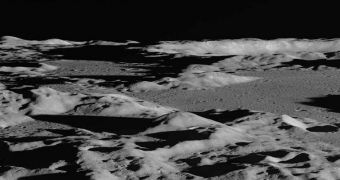For many years, scientists have believed that the Moon was a very dry and desolate place that could not support the development of water in any manner. The science against this seemed solid, so everyone was a bit shocked when instruments on an Indian probe discovered trace amounts of the liquid on the surface, and in some crater. In another instance, a NASA satellite found huge ice deposits in permanently-shadowed craters at the lunar south pole, and recent data also indicate huge amounts of water at the north pole as well. Now, investigators say that this water comes in three “flavors”.
Using the Mini-SAR and Moon Mineralogy Mapper (M3) instruments aboard the Indian-built Chandrayaan-1 spacecraft, experts managed to discover trace amounts of water on the lunar surface in mid-2009. As the scientists were thoroughly analyzing the datasets sent by the probe, experts at NASA were about to perform an experiment of their own. Using the Lunar Crater Observation and Sensing Satellite (LCROSS) impactor, and a spent Centaurus rocket stage, the scientists engineered a crash in a crater at the lunar south pole, where water-ice was discovered following spectral analysis of the debris.
“So far we've found three types of moon water. We have Mini-SAR's thick lenses of nearly pure crater ice, LCROSS's fluffy mix of ice crystals and dirt, and M-cube's thin layer that comes and goes all across the surface of the moon,” says expert Paul Spudis, who holds an appointment at the Houston, Texas-based Lunar and Planetary Institute, Space reports.
Speaking about the water-ice LCROSS found at the lunar south pole, the mission's principal investigator, Anthony Colaprete, said, “It looks as though at least two different layers of our crater soil contain water, and they represent two different time epochs. The first layer, ejected in the first 2 seconds from the crater after impact, contains water and hydroxyl bound up in the minerals, and even tiny pieces of pure ice mixed in. This layer is a thin film and may be relatively 'fresh,' perhaps recently replenished.”
The second layer that LCROSS identified is even more peculiar than the first, the expert says. “It contains even more water ice plus a treasure chest of other compounds we weren't even looking for, so far the tally includes sulfur dioxide (SO2), methanol (CH3OH), and the curious organic molecule diacetylene (H2C4). This layer seems to extend below at least 0.5 meters and is probably older than the ice we're finding on the surface,” Colaprete adds.

 14 DAY TRIAL //
14 DAY TRIAL //